ACC4029: Managerial Operations and Finance Case Study Analysis
VerifiedAdded on 2023/01/11
|15
|3571
|55
Case Study
AI Summary
This case study analysis examines the managerial operations and finance of Cucumber Ltd, a smartphone producer. The assignment addresses the role of management accounting in the management process, contrasting it with financial accounting, and explores costing models used in operational management, including specific order and operational costing, with marginal costing as an example. Capital investment appraisal techniques are applied to evaluate project proposals. The role of business plans and budgets in operational management is discussed, identifying areas for improvement, particularly in communication, forecasting, and budgeting flexibility. The case study also touches upon the usefulness of the Balanced Scorecard approach and its application to Cucumber Limited. The analysis covers financial targets, operational strategies, and the importance of aligning departmental goals with overall company objectives.
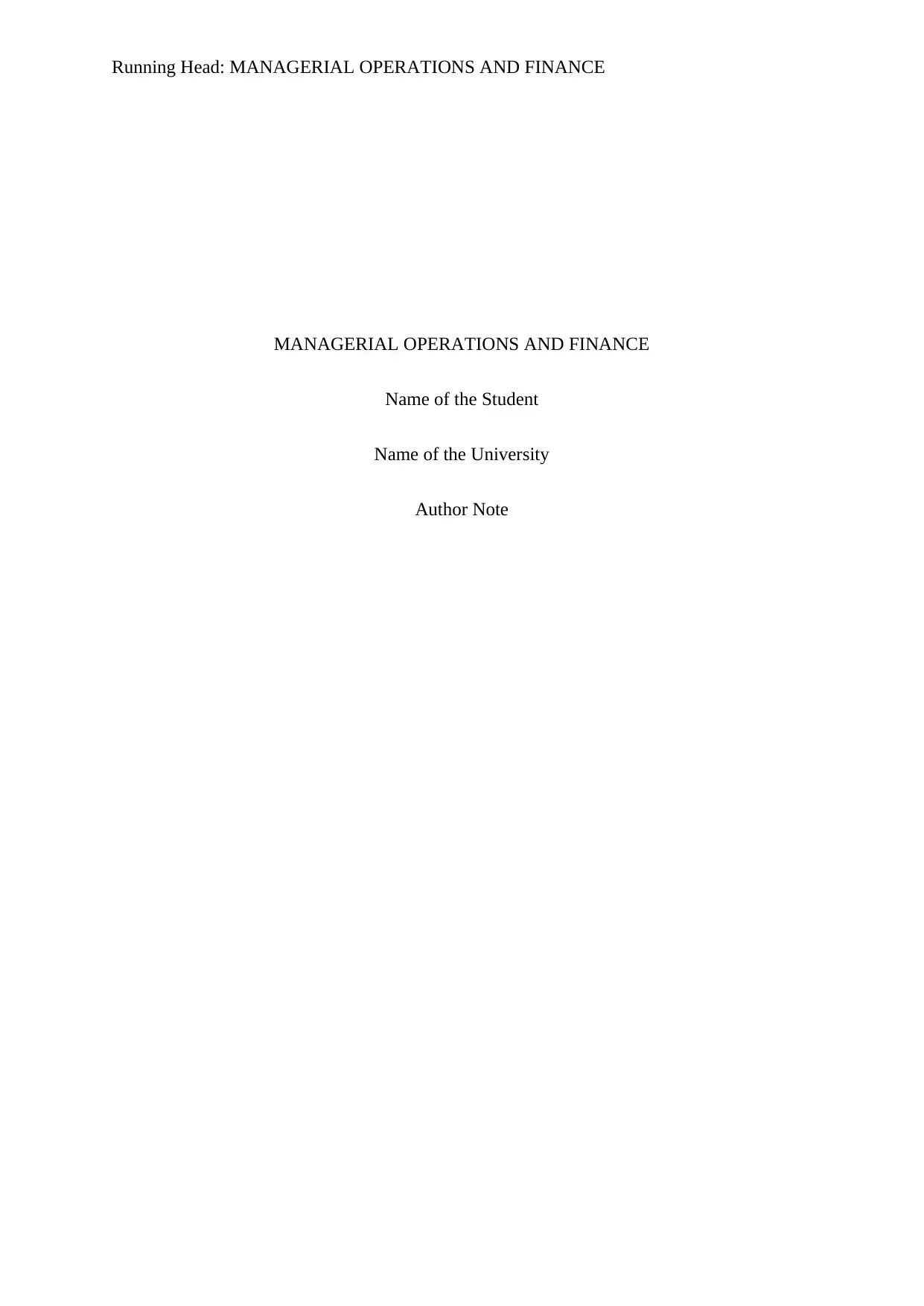
Running Head: MANAGERIAL OPERATIONS AND FINANCE
MANAGERIAL OPERATIONS AND FINANCE
Name of the Student
Name of the University
Author Note
MANAGERIAL OPERATIONS AND FINANCE
Name of the Student
Name of the University
Author Note
Paraphrase This Document
Need a fresh take? Get an instant paraphrase of this document with our AI Paraphraser
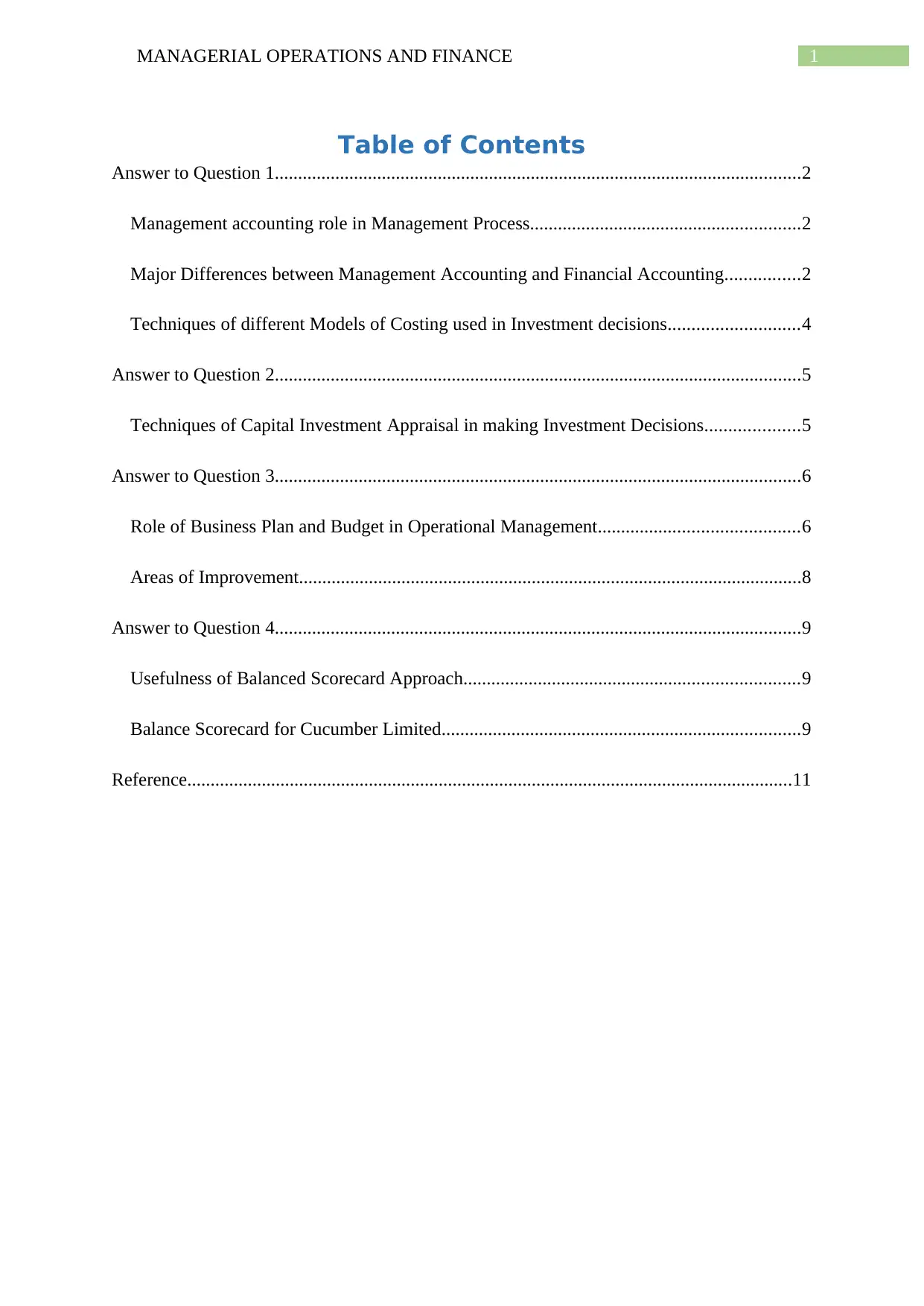
1MANAGERIAL OPERATIONS AND FINANCE
Table of Contents
Answer to Question 1.................................................................................................................2
Management accounting role in Management Process..........................................................2
Major Differences between Management Accounting and Financial Accounting................2
Techniques of different Models of Costing used in Investment decisions............................4
Answer to Question 2.................................................................................................................5
Techniques of Capital Investment Appraisal in making Investment Decisions....................5
Answer to Question 3.................................................................................................................6
Role of Business Plan and Budget in Operational Management...........................................6
Areas of Improvement............................................................................................................8
Answer to Question 4.................................................................................................................9
Usefulness of Balanced Scorecard Approach........................................................................9
Balance Scorecard for Cucumber Limited.............................................................................9
Reference..................................................................................................................................11
Table of Contents
Answer to Question 1.................................................................................................................2
Management accounting role in Management Process..........................................................2
Major Differences between Management Accounting and Financial Accounting................2
Techniques of different Models of Costing used in Investment decisions............................4
Answer to Question 2.................................................................................................................5
Techniques of Capital Investment Appraisal in making Investment Decisions....................5
Answer to Question 3.................................................................................................................6
Role of Business Plan and Budget in Operational Management...........................................6
Areas of Improvement............................................................................................................8
Answer to Question 4.................................................................................................................9
Usefulness of Balanced Scorecard Approach........................................................................9
Balance Scorecard for Cucumber Limited.............................................................................9
Reference..................................................................................................................................11
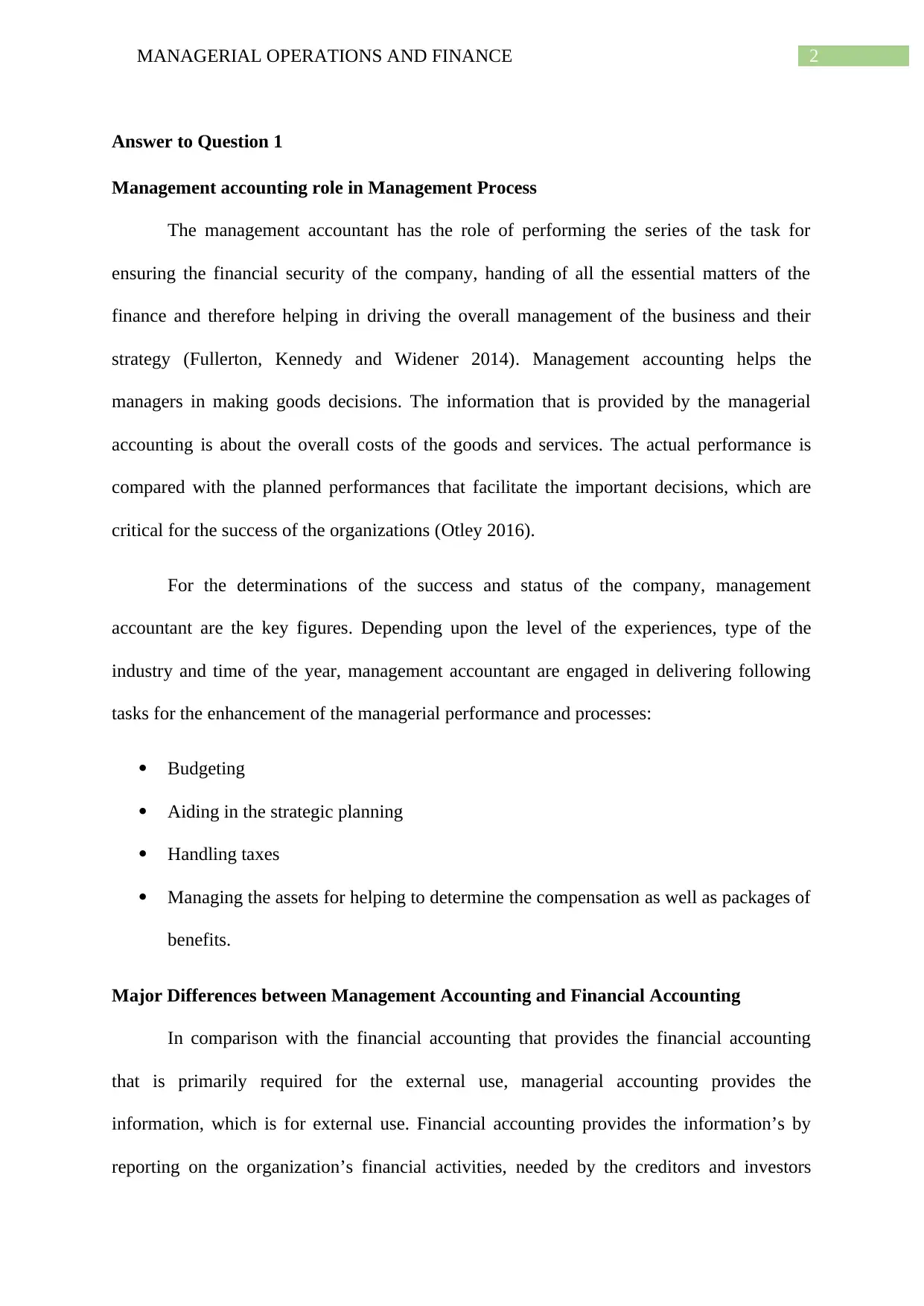
2MANAGERIAL OPERATIONS AND FINANCE
Answer to Question 1
Management accounting role in Management Process
The management accountant has the role of performing the series of the task for
ensuring the financial security of the company, handing of all the essential matters of the
finance and therefore helping in driving the overall management of the business and their
strategy (Fullerton, Kennedy and Widener 2014). Management accounting helps the
managers in making goods decisions. The information that is provided by the managerial
accounting is about the overall costs of the goods and services. The actual performance is
compared with the planned performances that facilitate the important decisions, which are
critical for the success of the organizations (Otley 2016).
For the determinations of the success and status of the company, management
accountant are the key figures. Depending upon the level of the experiences, type of the
industry and time of the year, management accountant are engaged in delivering following
tasks for the enhancement of the managerial performance and processes:
Budgeting
Aiding in the strategic planning
Handling taxes
Managing the assets for helping to determine the compensation as well as packages of
benefits.
Major Differences between Management Accounting and Financial Accounting
In comparison with the financial accounting that provides the financial accounting
that is primarily required for the external use, managerial accounting provides the
information, which is for external use. Financial accounting provides the information’s by
reporting on the organization’s financial activities, needed by the creditors and investors
Answer to Question 1
Management accounting role in Management Process
The management accountant has the role of performing the series of the task for
ensuring the financial security of the company, handing of all the essential matters of the
finance and therefore helping in driving the overall management of the business and their
strategy (Fullerton, Kennedy and Widener 2014). Management accounting helps the
managers in making goods decisions. The information that is provided by the managerial
accounting is about the overall costs of the goods and services. The actual performance is
compared with the planned performances that facilitate the important decisions, which are
critical for the success of the organizations (Otley 2016).
For the determinations of the success and status of the company, management
accountant are the key figures. Depending upon the level of the experiences, type of the
industry and time of the year, management accountant are engaged in delivering following
tasks for the enhancement of the managerial performance and processes:
Budgeting
Aiding in the strategic planning
Handling taxes
Managing the assets for helping to determine the compensation as well as packages of
benefits.
Major Differences between Management Accounting and Financial Accounting
In comparison with the financial accounting that provides the financial accounting
that is primarily required for the external use, managerial accounting provides the
information, which is for external use. Financial accounting provides the information’s by
reporting on the organization’s financial activities, needed by the creditors and investors
You're viewing a preview
Unlock full access by subscribing today!
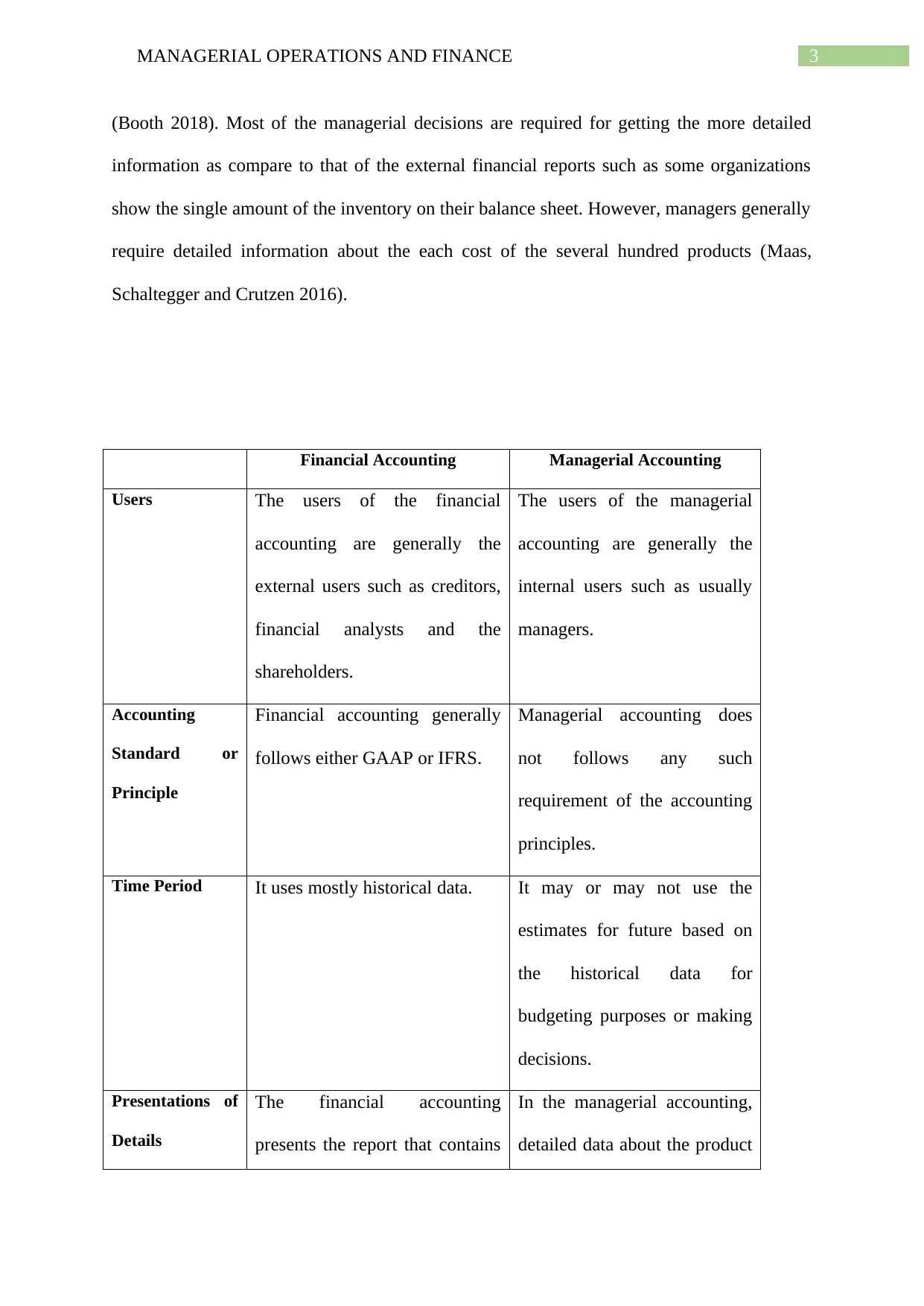
3MANAGERIAL OPERATIONS AND FINANCE
(Booth 2018). Most of the managerial decisions are required for getting the more detailed
information as compare to that of the external financial reports such as some organizations
show the single amount of the inventory on their balance sheet. However, managers generally
require detailed information about the each cost of the several hundred products (Maas,
Schaltegger and Crutzen 2016).
Financial Accounting Managerial Accounting
Users The users of the financial
accounting are generally the
external users such as creditors,
financial analysts and the
shareholders.
The users of the managerial
accounting are generally the
internal users such as usually
managers.
Accounting
Standard or
Principle
Financial accounting generally
follows either GAAP or IFRS.
Managerial accounting does
not follows any such
requirement of the accounting
principles.
Time Period It uses mostly historical data. It may or may not use the
estimates for future based on
the historical data for
budgeting purposes or making
decisions.
Presentations of
Details
The financial accounting
presents the report that contains
In the managerial accounting,
detailed data about the product
(Booth 2018). Most of the managerial decisions are required for getting the more detailed
information as compare to that of the external financial reports such as some organizations
show the single amount of the inventory on their balance sheet. However, managers generally
require detailed information about the each cost of the several hundred products (Maas,
Schaltegger and Crutzen 2016).
Financial Accounting Managerial Accounting
Users The users of the financial
accounting are generally the
external users such as creditors,
financial analysts and the
shareholders.
The users of the managerial
accounting are generally the
internal users such as usually
managers.
Accounting
Standard or
Principle
Financial accounting generally
follows either GAAP or IFRS.
Managerial accounting does
not follows any such
requirement of the accounting
principles.
Time Period It uses mostly historical data. It may or may not use the
estimates for future based on
the historical data for
budgeting purposes or making
decisions.
Presentations of
Details
The financial accounting
presents the report that contains
In the managerial accounting,
detailed data about the product
Paraphrase This Document
Need a fresh take? Get an instant paraphrase of this document with our AI Paraphraser
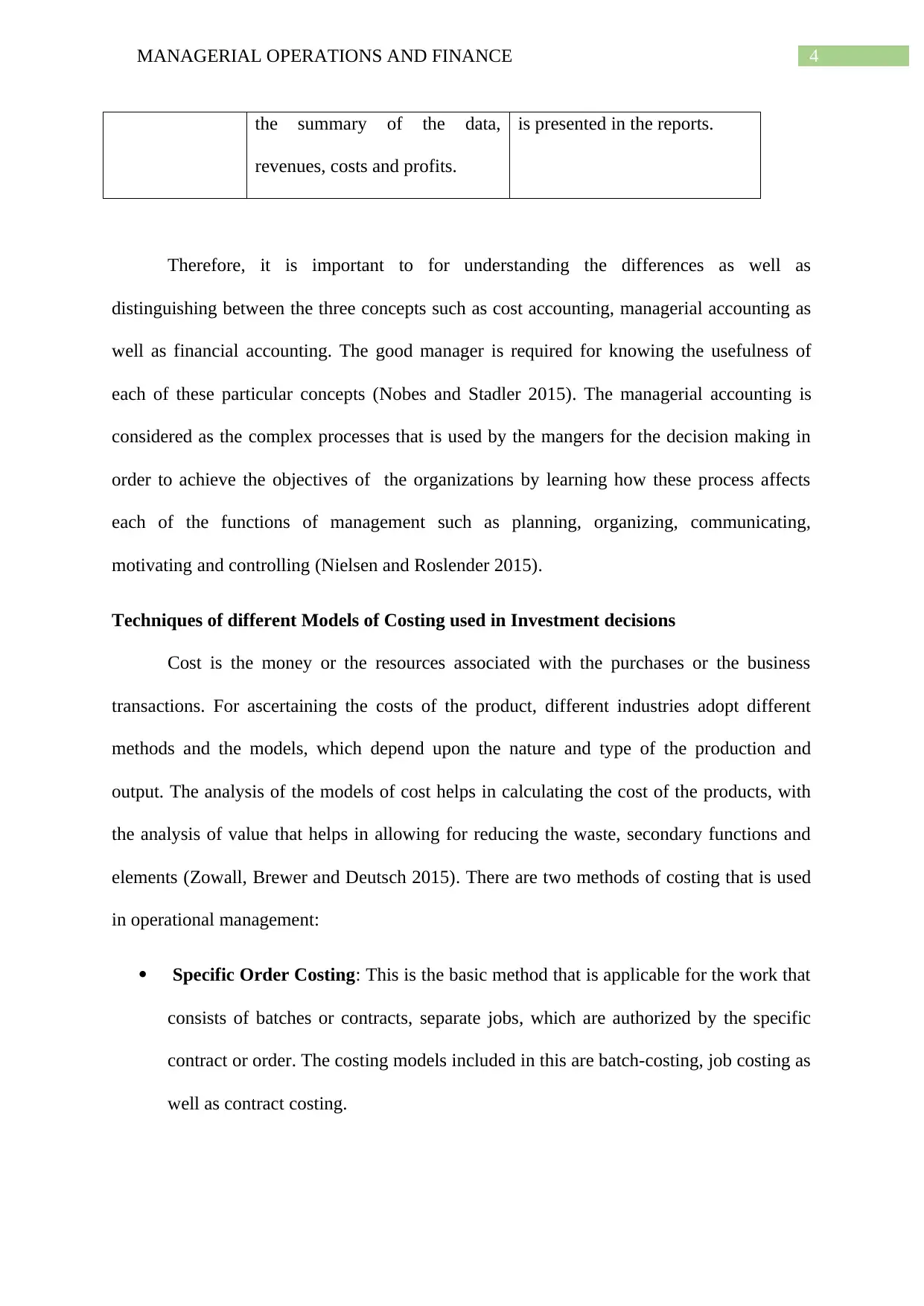
4MANAGERIAL OPERATIONS AND FINANCE
the summary of the data,
revenues, costs and profits.
is presented in the reports.
Therefore, it is important to for understanding the differences as well as
distinguishing between the three concepts such as cost accounting, managerial accounting as
well as financial accounting. The good manager is required for knowing the usefulness of
each of these particular concepts (Nobes and Stadler 2015). The managerial accounting is
considered as the complex processes that is used by the mangers for the decision making in
order to achieve the objectives of the organizations by learning how these process affects
each of the functions of management such as planning, organizing, communicating,
motivating and controlling (Nielsen and Roslender 2015).
Techniques of different Models of Costing used in Investment decisions
Cost is the money or the resources associated with the purchases or the business
transactions. For ascertaining the costs of the product, different industries adopt different
methods and the models, which depend upon the nature and type of the production and
output. The analysis of the models of cost helps in calculating the cost of the products, with
the analysis of value that helps in allowing for reducing the waste, secondary functions and
elements (Zowall, Brewer and Deutsch 2015). There are two methods of costing that is used
in operational management:
Specific Order Costing: This is the basic method that is applicable for the work that
consists of batches or contracts, separate jobs, which are authorized by the specific
contract or order. The costing models included in this are batch-costing, job costing as
well as contract costing.
the summary of the data,
revenues, costs and profits.
is presented in the reports.
Therefore, it is important to for understanding the differences as well as
distinguishing between the three concepts such as cost accounting, managerial accounting as
well as financial accounting. The good manager is required for knowing the usefulness of
each of these particular concepts (Nobes and Stadler 2015). The managerial accounting is
considered as the complex processes that is used by the mangers for the decision making in
order to achieve the objectives of the organizations by learning how these process affects
each of the functions of management such as planning, organizing, communicating,
motivating and controlling (Nielsen and Roslender 2015).
Techniques of different Models of Costing used in Investment decisions
Cost is the money or the resources associated with the purchases or the business
transactions. For ascertaining the costs of the product, different industries adopt different
methods and the models, which depend upon the nature and type of the production and
output. The analysis of the models of cost helps in calculating the cost of the products, with
the analysis of value that helps in allowing for reducing the waste, secondary functions and
elements (Zowall, Brewer and Deutsch 2015). There are two methods of costing that is used
in operational management:
Specific Order Costing: This is the basic method that is applicable for the work that
consists of batches or contracts, separate jobs, which are authorized by the specific
contract or order. The costing models included in this are batch-costing, job costing as
well as contract costing.
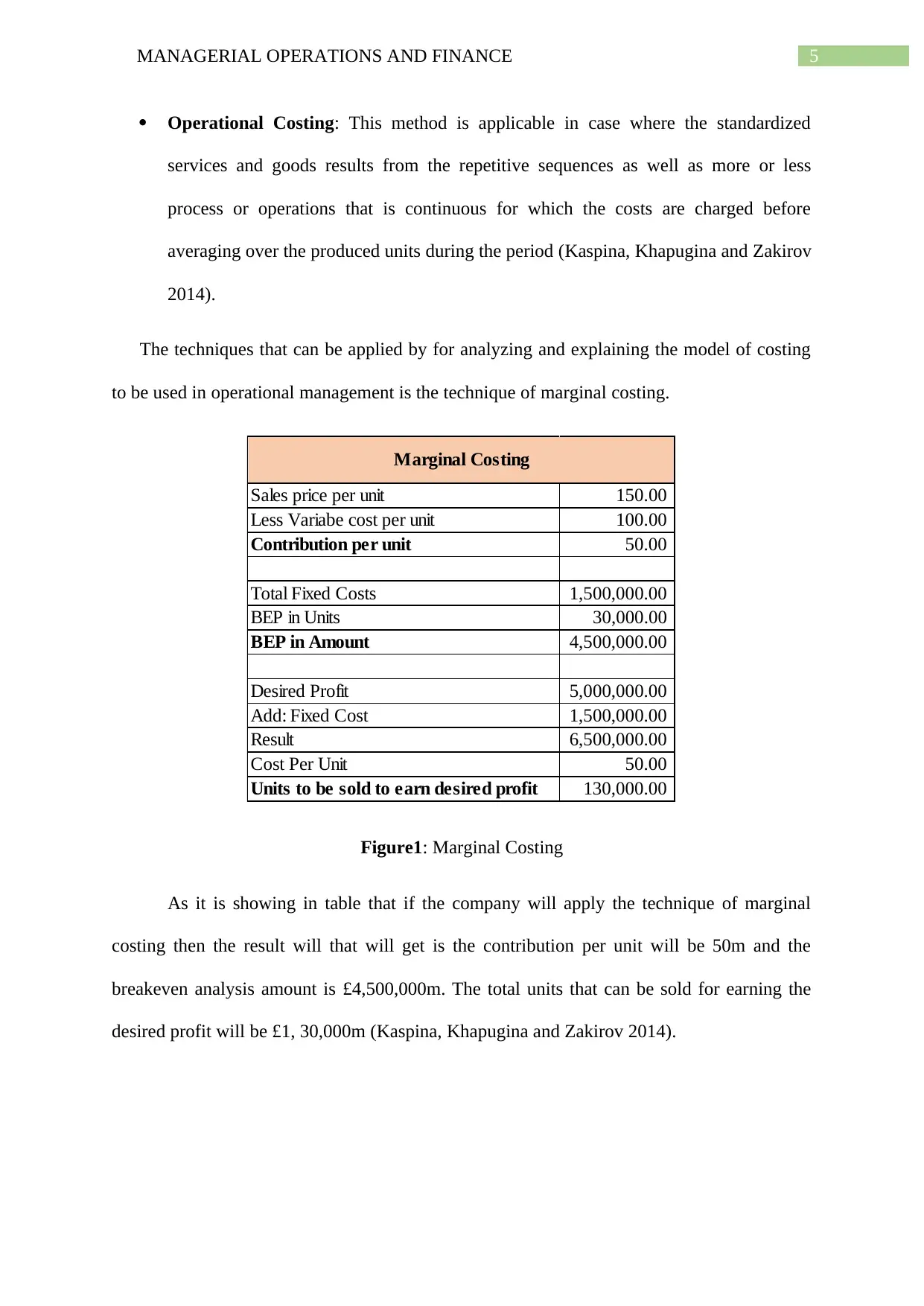
5MANAGERIAL OPERATIONS AND FINANCE
Operational Costing: This method is applicable in case where the standardized
services and goods results from the repetitive sequences as well as more or less
process or operations that is continuous for which the costs are charged before
averaging over the produced units during the period (Kaspina, Khapugina and Zakirov
2014).
The techniques that can be applied by for analyzing and explaining the model of costing
to be used in operational management is the technique of marginal costing.
Sales price per unit 150.00
Less Variabe cost per unit 100.00
Contribution per unit 50.00
Total Fixed Costs 1,500,000.00
BEP in Units 30,000.00
BEP in Amount 4,500,000.00
Desired Profit 5,000,000.00
Add: Fixed Cost 1,500,000.00
Result 6,500,000.00
Cost Per Unit 50.00
Units to be sold to earn desired profit 130,000.00
Marginal Costing
Figure1: Marginal Costing
As it is showing in table that if the company will apply the technique of marginal
costing then the result will that will get is the contribution per unit will be 50m and the
breakeven analysis amount is £4,500,000m. The total units that can be sold for earning the
desired profit will be £1, 30,000m (Kaspina, Khapugina and Zakirov 2014).
Operational Costing: This method is applicable in case where the standardized
services and goods results from the repetitive sequences as well as more or less
process or operations that is continuous for which the costs are charged before
averaging over the produced units during the period (Kaspina, Khapugina and Zakirov
2014).
The techniques that can be applied by for analyzing and explaining the model of costing
to be used in operational management is the technique of marginal costing.
Sales price per unit 150.00
Less Variabe cost per unit 100.00
Contribution per unit 50.00
Total Fixed Costs 1,500,000.00
BEP in Units 30,000.00
BEP in Amount 4,500,000.00
Desired Profit 5,000,000.00
Add: Fixed Cost 1,500,000.00
Result 6,500,000.00
Cost Per Unit 50.00
Units to be sold to earn desired profit 130,000.00
Marginal Costing
Figure1: Marginal Costing
As it is showing in table that if the company will apply the technique of marginal
costing then the result will that will get is the contribution per unit will be 50m and the
breakeven analysis amount is £4,500,000m. The total units that can be sold for earning the
desired profit will be £1, 30,000m (Kaspina, Khapugina and Zakirov 2014).
You're viewing a preview
Unlock full access by subscribing today!
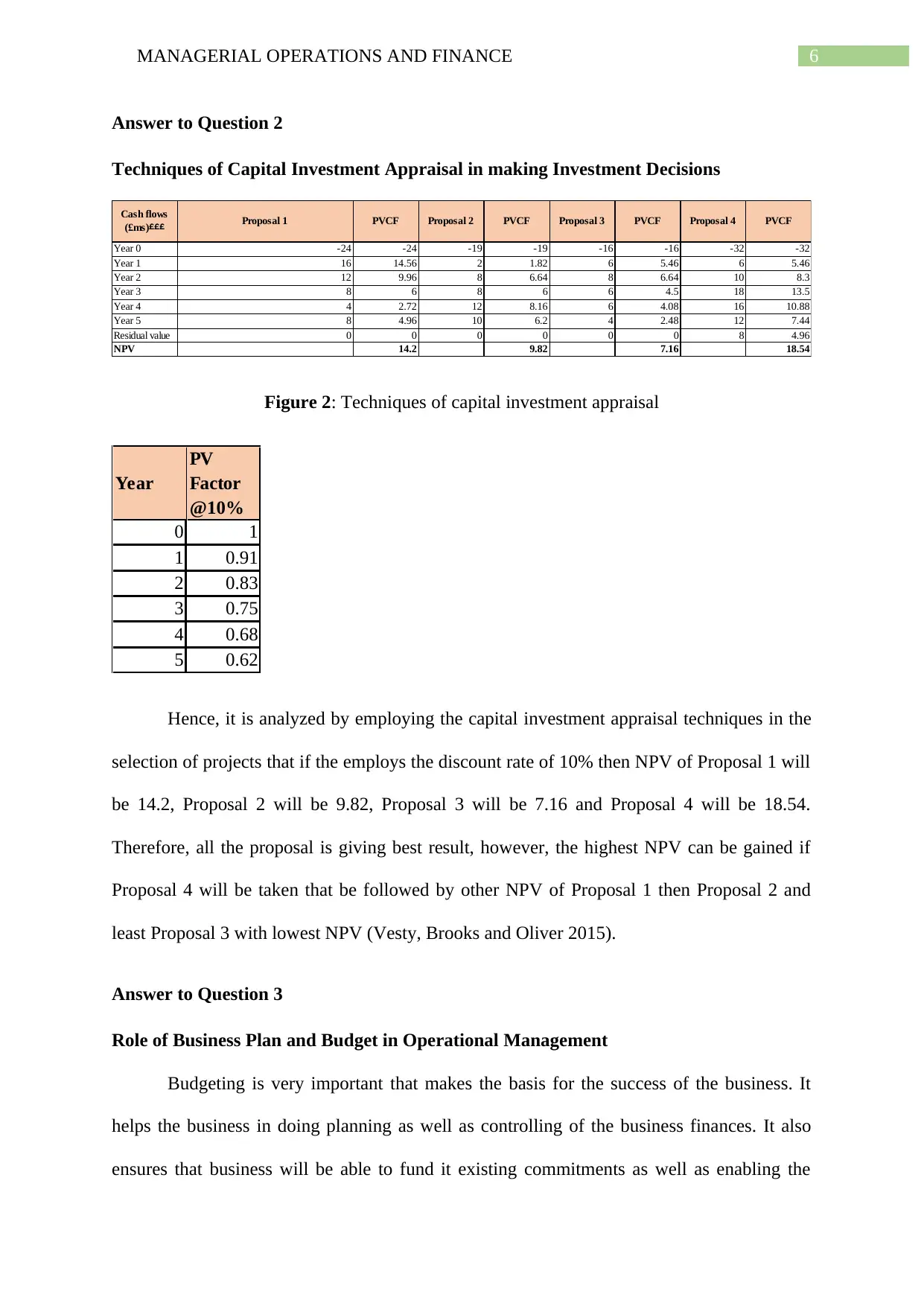
6MANAGERIAL OPERATIONS AND FINANCE
Answer to Question 2
Techniques of Capital Investment Appraisal in making Investment Decisions
Cash flows
(£ms)£££ Proposal 1 PVCF Proposal 2 PVCF Proposal 3 PVCF Proposal 4 PVCF
Year 0 -24 -24 -19 -19 -16 -16 -32 -32
Year 1 16 14.56 2 1.82 6 5.46 6 5.46
Year 2 12 9.96 8 6.64 8 6.64 10 8.3
Year 3 8 6 8 6 6 4.5 18 13.5
Year 4 4 2.72 12 8.16 6 4.08 16 10.88
Year 5 8 4.96 10 6.2 4 2.48 12 7.44
Residual value 0 0 0 0 0 0 8 4.96
NPV 14.2 9.82 7.16 18.54
Figure 2: Techniques of capital investment appraisal
Year
PV
Factor
@10%
0 1
1 0.91
2 0.83
3 0.75
4 0.68
5 0.62
Hence, it is analyzed by employing the capital investment appraisal techniques in the
selection of projects that if the employs the discount rate of 10% then NPV of Proposal 1 will
be 14.2, Proposal 2 will be 9.82, Proposal 3 will be 7.16 and Proposal 4 will be 18.54.
Therefore, all the proposal is giving best result, however, the highest NPV can be gained if
Proposal 4 will be taken that be followed by other NPV of Proposal 1 then Proposal 2 and
least Proposal 3 with lowest NPV (Vesty, Brooks and Oliver 2015).
Answer to Question 3
Role of Business Plan and Budget in Operational Management
Budgeting is very important that makes the basis for the success of the business. It
helps the business in doing planning as well as controlling of the business finances. It also
ensures that business will be able to fund it existing commitments as well as enabling the
Answer to Question 2
Techniques of Capital Investment Appraisal in making Investment Decisions
Cash flows
(£ms)£££ Proposal 1 PVCF Proposal 2 PVCF Proposal 3 PVCF Proposal 4 PVCF
Year 0 -24 -24 -19 -19 -16 -16 -32 -32
Year 1 16 14.56 2 1.82 6 5.46 6 5.46
Year 2 12 9.96 8 6.64 8 6.64 10 8.3
Year 3 8 6 8 6 6 4.5 18 13.5
Year 4 4 2.72 12 8.16 6 4.08 16 10.88
Year 5 8 4.96 10 6.2 4 2.48 12 7.44
Residual value 0 0 0 0 0 0 8 4.96
NPV 14.2 9.82 7.16 18.54
Figure 2: Techniques of capital investment appraisal
Year
PV
Factor
@10%
0 1
1 0.91
2 0.83
3 0.75
4 0.68
5 0.62
Hence, it is analyzed by employing the capital investment appraisal techniques in the
selection of projects that if the employs the discount rate of 10% then NPV of Proposal 1 will
be 14.2, Proposal 2 will be 9.82, Proposal 3 will be 7.16 and Proposal 4 will be 18.54.
Therefore, all the proposal is giving best result, however, the highest NPV can be gained if
Proposal 4 will be taken that be followed by other NPV of Proposal 1 then Proposal 2 and
least Proposal 3 with lowest NPV (Vesty, Brooks and Oliver 2015).
Answer to Question 3
Role of Business Plan and Budget in Operational Management
Budgeting is very important that makes the basis for the success of the business. It
helps the business in doing planning as well as controlling of the business finances. It also
ensures that business will be able to fund it existing commitments as well as enabling the
Paraphrase This Document
Need a fresh take? Get an instant paraphrase of this document with our AI Paraphraser
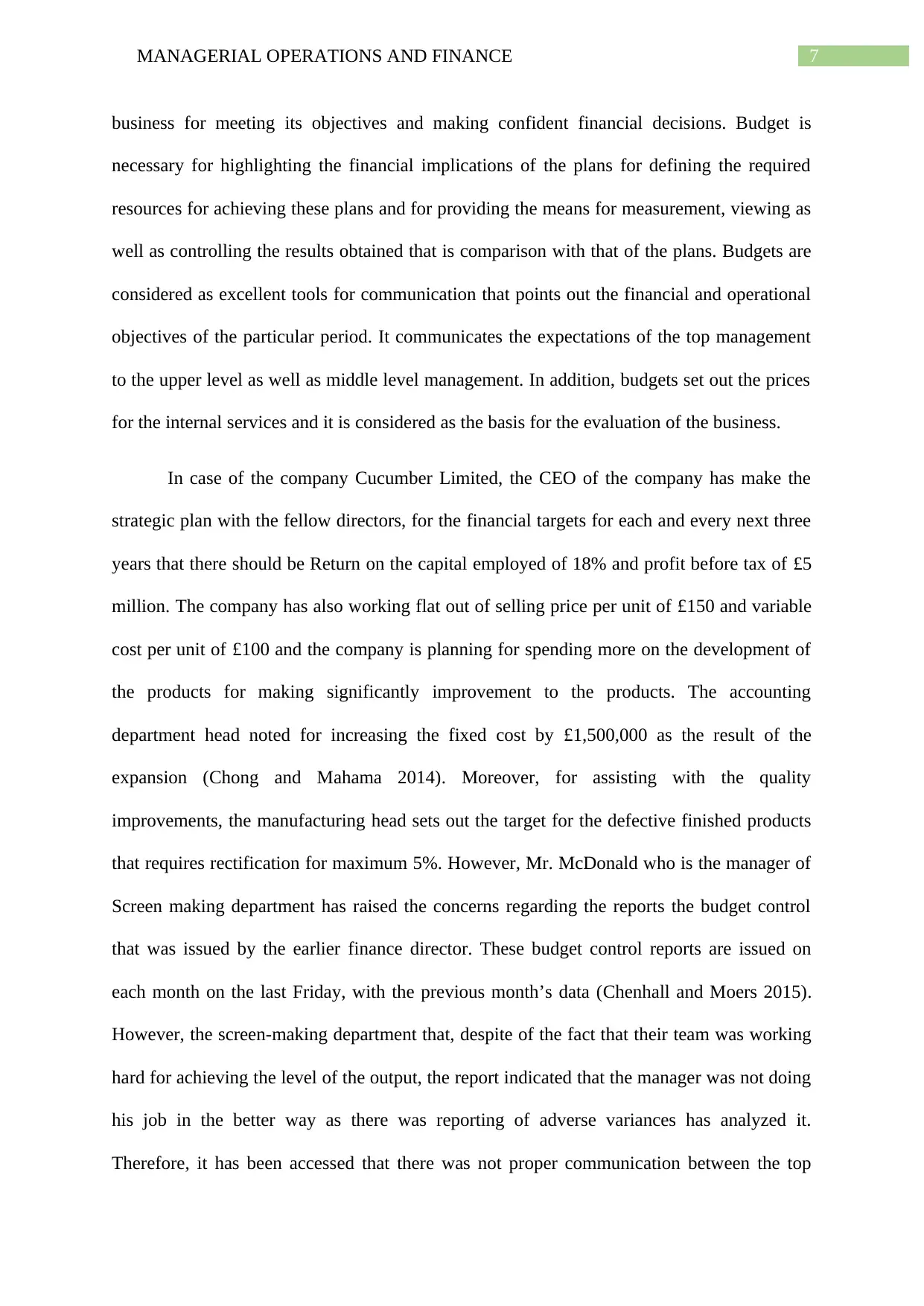
7MANAGERIAL OPERATIONS AND FINANCE
business for meeting its objectives and making confident financial decisions. Budget is
necessary for highlighting the financial implications of the plans for defining the required
resources for achieving these plans and for providing the means for measurement, viewing as
well as controlling the results obtained that is comparison with that of the plans. Budgets are
considered as excellent tools for communication that points out the financial and operational
objectives of the particular period. It communicates the expectations of the top management
to the upper level as well as middle level management. In addition, budgets set out the prices
for the internal services and it is considered as the basis for the evaluation of the business.
In case of the company Cucumber Limited, the CEO of the company has make the
strategic plan with the fellow directors, for the financial targets for each and every next three
years that there should be Return on the capital employed of 18% and profit before tax of £5
million. The company has also working flat out of selling price per unit of £150 and variable
cost per unit of £100 and the company is planning for spending more on the development of
the products for making significantly improvement to the products. The accounting
department head noted for increasing the fixed cost by £1,500,000 as the result of the
expansion (Chong and Mahama 2014). Moreover, for assisting with the quality
improvements, the manufacturing head sets out the target for the defective finished products
that requires rectification for maximum 5%. However, Mr. McDonald who is the manager of
Screen making department has raised the concerns regarding the reports the budget control
that was issued by the earlier finance director. These budget control reports are issued on
each month on the last Friday, with the previous month’s data (Chenhall and Moers 2015).
However, the screen-making department that, despite of the fact that their team was working
hard for achieving the level of the output, the report indicated that the manager was not doing
his job in the better way as there was reporting of adverse variances has analyzed it.
Therefore, it has been accessed that there was not proper communication between the top
business for meeting its objectives and making confident financial decisions. Budget is
necessary for highlighting the financial implications of the plans for defining the required
resources for achieving these plans and for providing the means for measurement, viewing as
well as controlling the results obtained that is comparison with that of the plans. Budgets are
considered as excellent tools for communication that points out the financial and operational
objectives of the particular period. It communicates the expectations of the top management
to the upper level as well as middle level management. In addition, budgets set out the prices
for the internal services and it is considered as the basis for the evaluation of the business.
In case of the company Cucumber Limited, the CEO of the company has make the
strategic plan with the fellow directors, for the financial targets for each and every next three
years that there should be Return on the capital employed of 18% and profit before tax of £5
million. The company has also working flat out of selling price per unit of £150 and variable
cost per unit of £100 and the company is planning for spending more on the development of
the products for making significantly improvement to the products. The accounting
department head noted for increasing the fixed cost by £1,500,000 as the result of the
expansion (Chong and Mahama 2014). Moreover, for assisting with the quality
improvements, the manufacturing head sets out the target for the defective finished products
that requires rectification for maximum 5%. However, Mr. McDonald who is the manager of
Screen making department has raised the concerns regarding the reports the budget control
that was issued by the earlier finance director. These budget control reports are issued on
each month on the last Friday, with the previous month’s data (Chenhall and Moers 2015).
However, the screen-making department that, despite of the fact that their team was working
hard for achieving the level of the output, the report indicated that the manager was not doing
his job in the better way as there was reporting of adverse variances has analyzed it.
Therefore, it has been accessed that there was not proper communication between the top
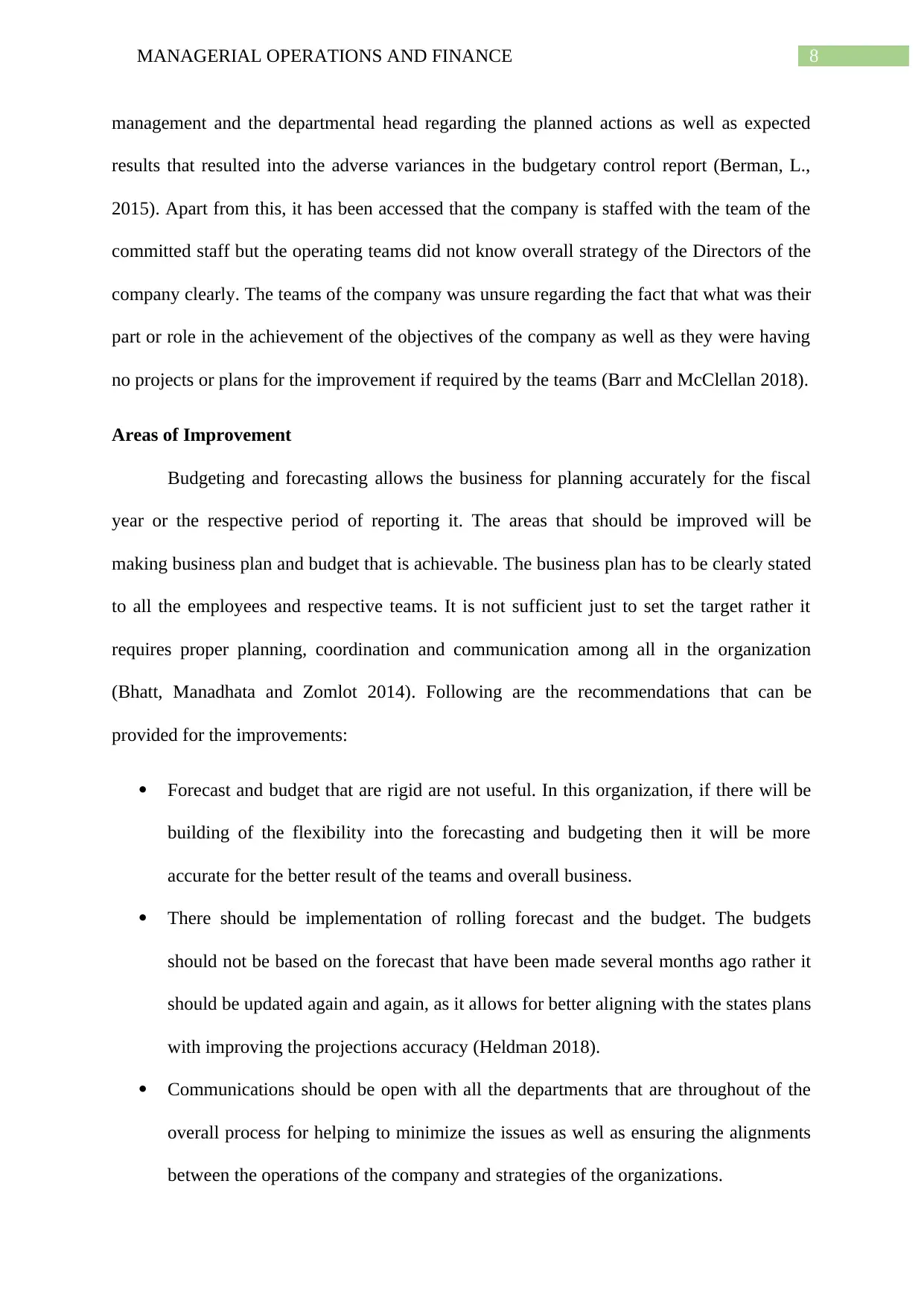
8MANAGERIAL OPERATIONS AND FINANCE
management and the departmental head regarding the planned actions as well as expected
results that resulted into the adverse variances in the budgetary control report (Berman, L.,
2015). Apart from this, it has been accessed that the company is staffed with the team of the
committed staff but the operating teams did not know overall strategy of the Directors of the
company clearly. The teams of the company was unsure regarding the fact that what was their
part or role in the achievement of the objectives of the company as well as they were having
no projects or plans for the improvement if required by the teams (Barr and McClellan 2018).
Areas of Improvement
Budgeting and forecasting allows the business for planning accurately for the fiscal
year or the respective period of reporting it. The areas that should be improved will be
making business plan and budget that is achievable. The business plan has to be clearly stated
to all the employees and respective teams. It is not sufficient just to set the target rather it
requires proper planning, coordination and communication among all in the organization
(Bhatt, Manadhata and Zomlot 2014). Following are the recommendations that can be
provided for the improvements:
Forecast and budget that are rigid are not useful. In this organization, if there will be
building of the flexibility into the forecasting and budgeting then it will be more
accurate for the better result of the teams and overall business.
There should be implementation of rolling forecast and the budget. The budgets
should not be based on the forecast that have been made several months ago rather it
should be updated again and again, as it allows for better aligning with the states plans
with improving the projections accuracy (Heldman 2018).
Communications should be open with all the departments that are throughout of the
overall process for helping to minimize the issues as well as ensuring the alignments
between the operations of the company and strategies of the organizations.
management and the departmental head regarding the planned actions as well as expected
results that resulted into the adverse variances in the budgetary control report (Berman, L.,
2015). Apart from this, it has been accessed that the company is staffed with the team of the
committed staff but the operating teams did not know overall strategy of the Directors of the
company clearly. The teams of the company was unsure regarding the fact that what was their
part or role in the achievement of the objectives of the company as well as they were having
no projects or plans for the improvement if required by the teams (Barr and McClellan 2018).
Areas of Improvement
Budgeting and forecasting allows the business for planning accurately for the fiscal
year or the respective period of reporting it. The areas that should be improved will be
making business plan and budget that is achievable. The business plan has to be clearly stated
to all the employees and respective teams. It is not sufficient just to set the target rather it
requires proper planning, coordination and communication among all in the organization
(Bhatt, Manadhata and Zomlot 2014). Following are the recommendations that can be
provided for the improvements:
Forecast and budget that are rigid are not useful. In this organization, if there will be
building of the flexibility into the forecasting and budgeting then it will be more
accurate for the better result of the teams and overall business.
There should be implementation of rolling forecast and the budget. The budgets
should not be based on the forecast that have been made several months ago rather it
should be updated again and again, as it allows for better aligning with the states plans
with improving the projections accuracy (Heldman 2018).
Communications should be open with all the departments that are throughout of the
overall process for helping to minimize the issues as well as ensuring the alignments
between the operations of the company and strategies of the organizations.
You're viewing a preview
Unlock full access by subscribing today!
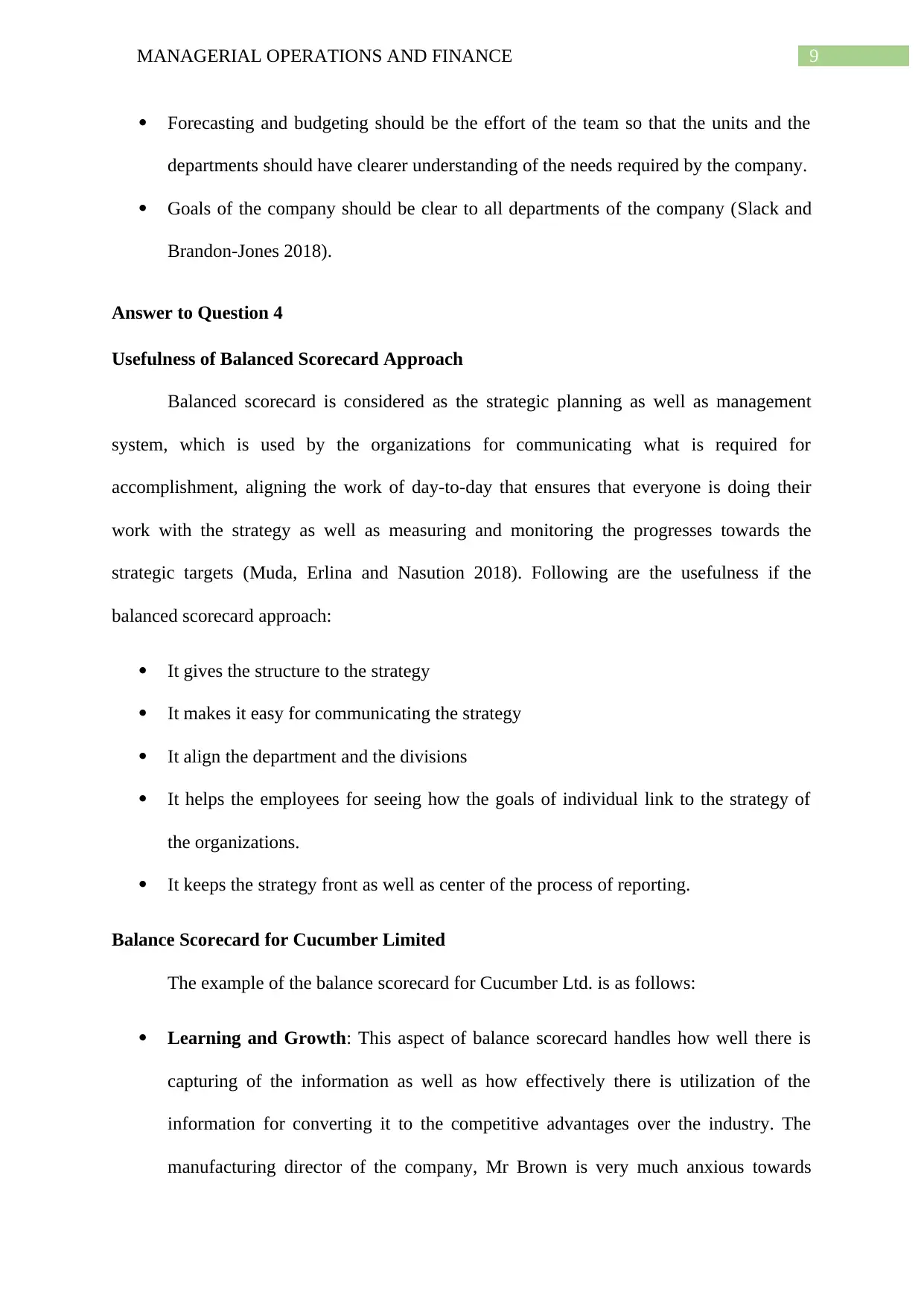
9MANAGERIAL OPERATIONS AND FINANCE
Forecasting and budgeting should be the effort of the team so that the units and the
departments should have clearer understanding of the needs required by the company.
Goals of the company should be clear to all departments of the company (Slack and
Brandon-Jones 2018).
Answer to Question 4
Usefulness of Balanced Scorecard Approach
Balanced scorecard is considered as the strategic planning as well as management
system, which is used by the organizations for communicating what is required for
accomplishment, aligning the work of day-to-day that ensures that everyone is doing their
work with the strategy as well as measuring and monitoring the progresses towards the
strategic targets (Muda, Erlina and Nasution 2018). Following are the usefulness if the
balanced scorecard approach:
It gives the structure to the strategy
It makes it easy for communicating the strategy
It align the department and the divisions
It helps the employees for seeing how the goals of individual link to the strategy of
the organizations.
It keeps the strategy front as well as center of the process of reporting.
Balance Scorecard for Cucumber Limited
The example of the balance scorecard for Cucumber Ltd. is as follows:
Learning and Growth: This aspect of balance scorecard handles how well there is
capturing of the information as well as how effectively there is utilization of the
information for converting it to the competitive advantages over the industry. The
manufacturing director of the company, Mr Brown is very much anxious towards
Forecasting and budgeting should be the effort of the team so that the units and the
departments should have clearer understanding of the needs required by the company.
Goals of the company should be clear to all departments of the company (Slack and
Brandon-Jones 2018).
Answer to Question 4
Usefulness of Balanced Scorecard Approach
Balanced scorecard is considered as the strategic planning as well as management
system, which is used by the organizations for communicating what is required for
accomplishment, aligning the work of day-to-day that ensures that everyone is doing their
work with the strategy as well as measuring and monitoring the progresses towards the
strategic targets (Muda, Erlina and Nasution 2018). Following are the usefulness if the
balanced scorecard approach:
It gives the structure to the strategy
It makes it easy for communicating the strategy
It align the department and the divisions
It helps the employees for seeing how the goals of individual link to the strategy of
the organizations.
It keeps the strategy front as well as center of the process of reporting.
Balance Scorecard for Cucumber Limited
The example of the balance scorecard for Cucumber Ltd. is as follows:
Learning and Growth: This aspect of balance scorecard handles how well there is
capturing of the information as well as how effectively there is utilization of the
information for converting it to the competitive advantages over the industry. The
manufacturing director of the company, Mr Brown is very much anxious towards
Paraphrase This Document
Need a fresh take? Get an instant paraphrase of this document with our AI Paraphraser
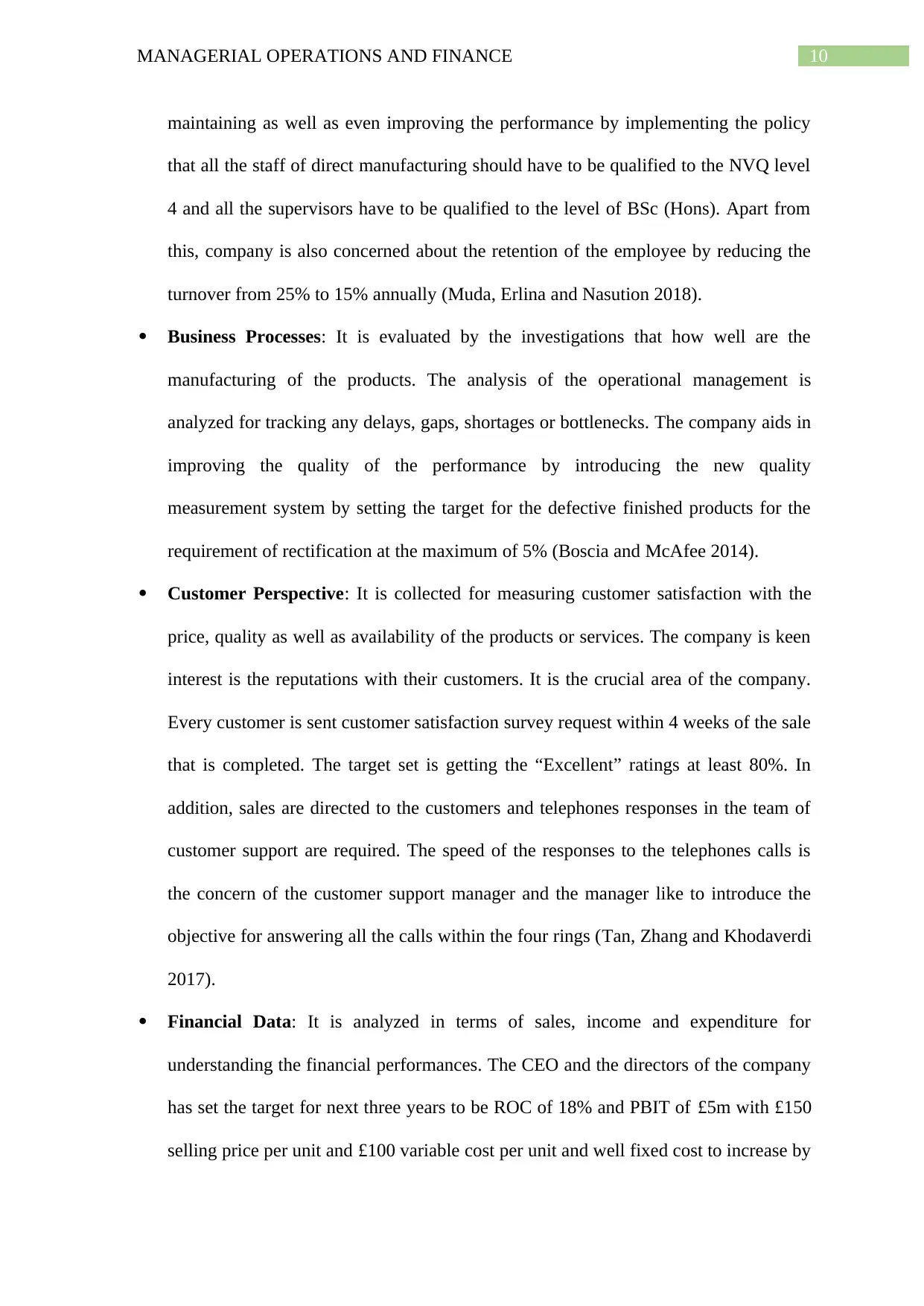
10MANAGERIAL OPERATIONS AND FINANCE
maintaining as well as even improving the performance by implementing the policy
that all the staff of direct manufacturing should have to be qualified to the NVQ level
4 and all the supervisors have to be qualified to the level of BSc (Hons). Apart from
this, company is also concerned about the retention of the employee by reducing the
turnover from 25% to 15% annually (Muda, Erlina and Nasution 2018).
Business Processes: It is evaluated by the investigations that how well are the
manufacturing of the products. The analysis of the operational management is
analyzed for tracking any delays, gaps, shortages or bottlenecks. The company aids in
improving the quality of the performance by introducing the new quality
measurement system by setting the target for the defective finished products for the
requirement of rectification at the maximum of 5% (Boscia and McAfee 2014).
Customer Perspective: It is collected for measuring customer satisfaction with the
price, quality as well as availability of the products or services. The company is keen
interest is the reputations with their customers. It is the crucial area of the company.
Every customer is sent customer satisfaction survey request within 4 weeks of the sale
that is completed. The target set is getting the “Excellent” ratings at least 80%. In
addition, sales are directed to the customers and telephones responses in the team of
customer support are required. The speed of the responses to the telephones calls is
the concern of the customer support manager and the manager like to introduce the
objective for answering all the calls within the four rings (Tan, Zhang and Khodaverdi
2017).
Financial Data: It is analyzed in terms of sales, income and expenditure for
understanding the financial performances. The CEO and the directors of the company
has set the target for next three years to be ROC of 18% and PBIT of £5m with £150
selling price per unit and £100 variable cost per unit and well fixed cost to increase by
maintaining as well as even improving the performance by implementing the policy
that all the staff of direct manufacturing should have to be qualified to the NVQ level
4 and all the supervisors have to be qualified to the level of BSc (Hons). Apart from
this, company is also concerned about the retention of the employee by reducing the
turnover from 25% to 15% annually (Muda, Erlina and Nasution 2018).
Business Processes: It is evaluated by the investigations that how well are the
manufacturing of the products. The analysis of the operational management is
analyzed for tracking any delays, gaps, shortages or bottlenecks. The company aids in
improving the quality of the performance by introducing the new quality
measurement system by setting the target for the defective finished products for the
requirement of rectification at the maximum of 5% (Boscia and McAfee 2014).
Customer Perspective: It is collected for measuring customer satisfaction with the
price, quality as well as availability of the products or services. The company is keen
interest is the reputations with their customers. It is the crucial area of the company.
Every customer is sent customer satisfaction survey request within 4 weeks of the sale
that is completed. The target set is getting the “Excellent” ratings at least 80%. In
addition, sales are directed to the customers and telephones responses in the team of
customer support are required. The speed of the responses to the telephones calls is
the concern of the customer support manager and the manager like to introduce the
objective for answering all the calls within the four rings (Tan, Zhang and Khodaverdi
2017).
Financial Data: It is analyzed in terms of sales, income and expenditure for
understanding the financial performances. The CEO and the directors of the company
has set the target for next three years to be ROC of 18% and PBIT of £5m with £150
selling price per unit and £100 variable cost per unit and well fixed cost to increase by
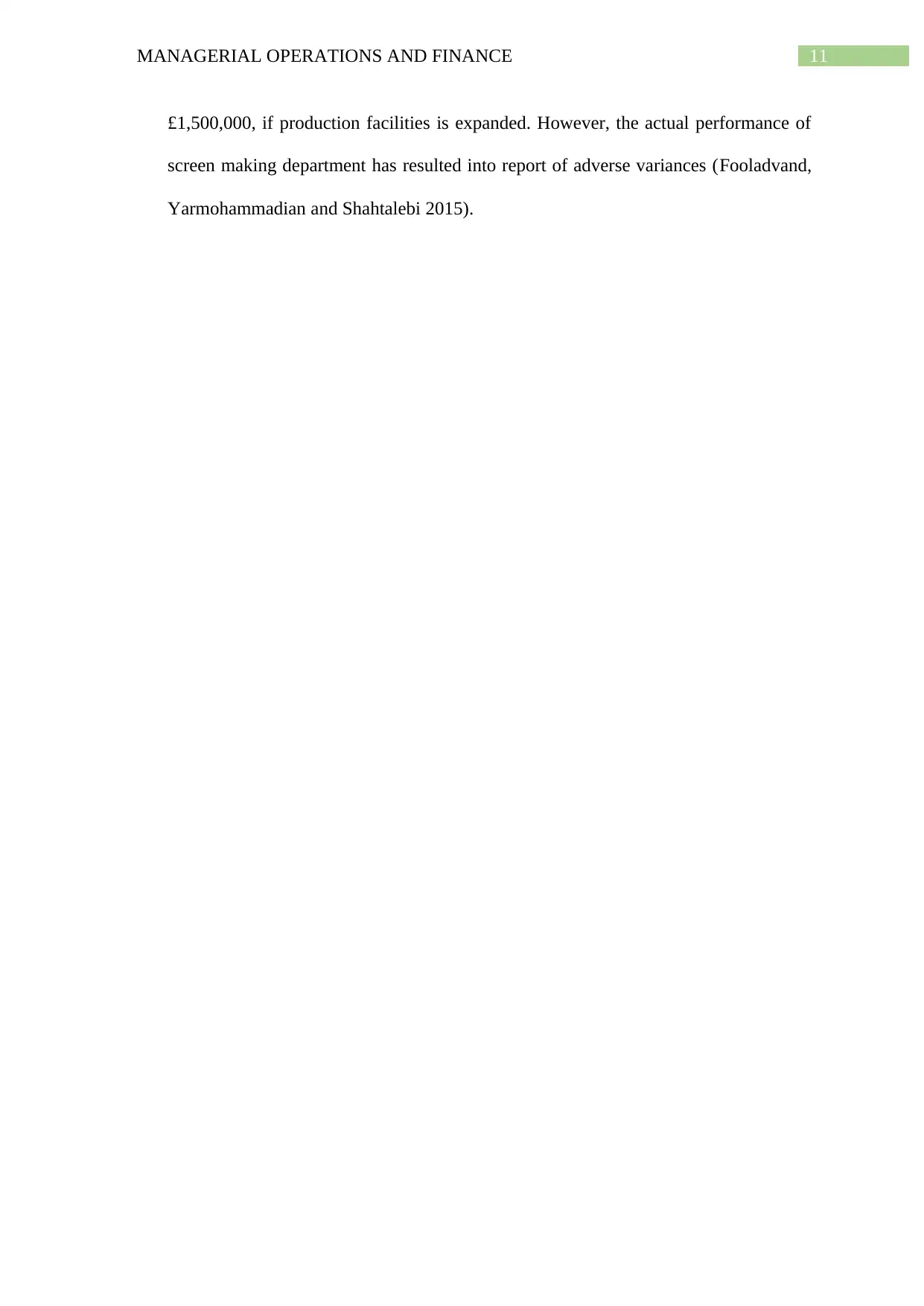
11MANAGERIAL OPERATIONS AND FINANCE
£1,500,000, if production facilities is expanded. However, the actual performance of
screen making department has resulted into report of adverse variances (Fooladvand,
Yarmohammadian and Shahtalebi 2015).
£1,500,000, if production facilities is expanded. However, the actual performance of
screen making department has resulted into report of adverse variances (Fooladvand,
Yarmohammadian and Shahtalebi 2015).
You're viewing a preview
Unlock full access by subscribing today!
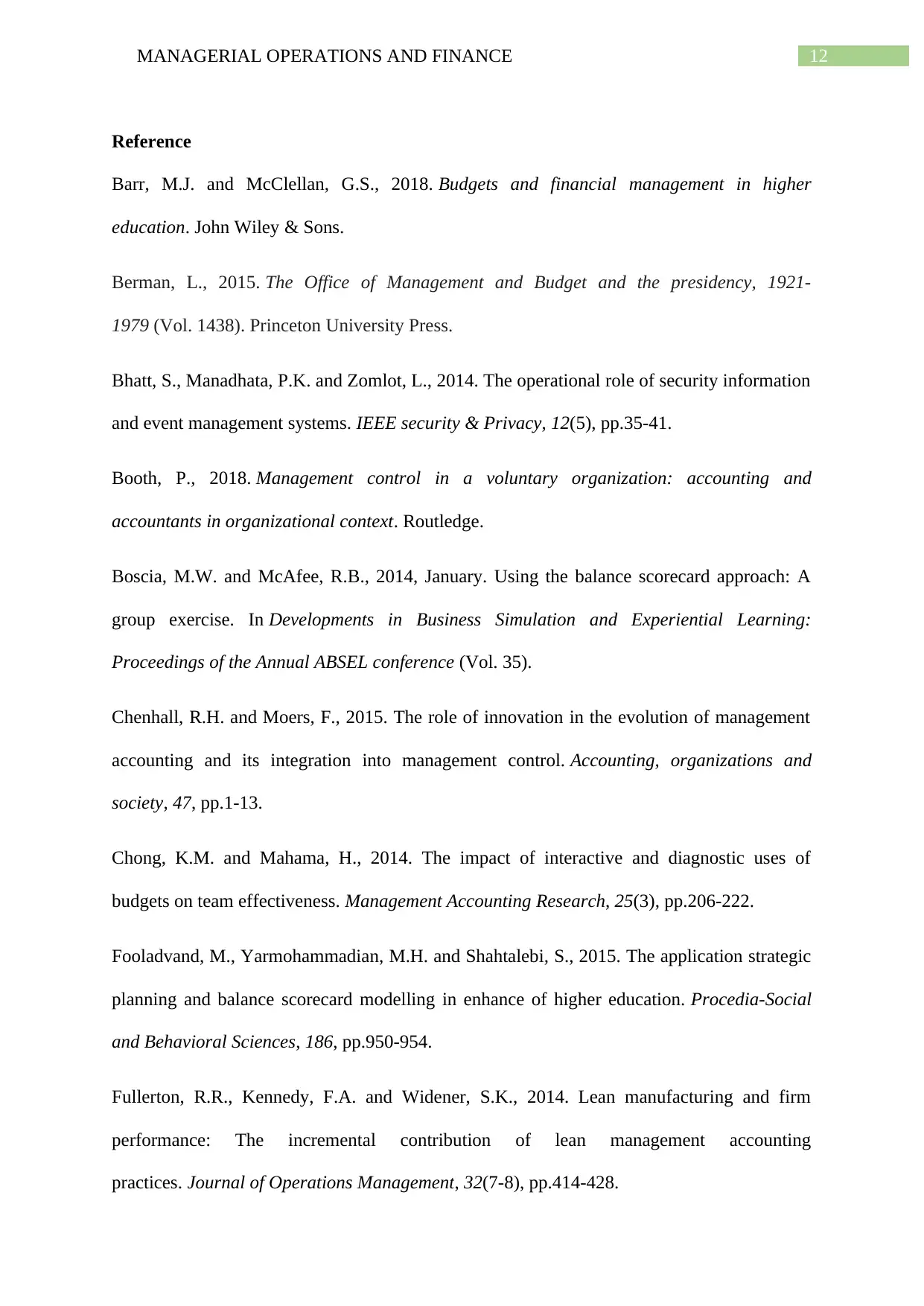
12MANAGERIAL OPERATIONS AND FINANCE
Reference
Barr, M.J. and McClellan, G.S., 2018. Budgets and financial management in higher
education. John Wiley & Sons.
Berman, L., 2015. The Office of Management and Budget and the presidency, 1921-
1979 (Vol. 1438). Princeton University Press.
Bhatt, S., Manadhata, P.K. and Zomlot, L., 2014. The operational role of security information
and event management systems. IEEE security & Privacy, 12(5), pp.35-41.
Booth, P., 2018. Management control in a voluntary organization: accounting and
accountants in organizational context. Routledge.
Boscia, M.W. and McAfee, R.B., 2014, January. Using the balance scorecard approach: A
group exercise. In Developments in Business Simulation and Experiential Learning:
Proceedings of the Annual ABSEL conference (Vol. 35).
Chenhall, R.H. and Moers, F., 2015. The role of innovation in the evolution of management
accounting and its integration into management control. Accounting, organizations and
society, 47, pp.1-13.
Chong, K.M. and Mahama, H., 2014. The impact of interactive and diagnostic uses of
budgets on team effectiveness. Management Accounting Research, 25(3), pp.206-222.
Fooladvand, M., Yarmohammadian, M.H. and Shahtalebi, S., 2015. The application strategic
planning and balance scorecard modelling in enhance of higher education. Procedia-Social
and Behavioral Sciences, 186, pp.950-954.
Fullerton, R.R., Kennedy, F.A. and Widener, S.K., 2014. Lean manufacturing and firm
performance: The incremental contribution of lean management accounting
practices. Journal of Operations Management, 32(7-8), pp.414-428.
Reference
Barr, M.J. and McClellan, G.S., 2018. Budgets and financial management in higher
education. John Wiley & Sons.
Berman, L., 2015. The Office of Management and Budget and the presidency, 1921-
1979 (Vol. 1438). Princeton University Press.
Bhatt, S., Manadhata, P.K. and Zomlot, L., 2014. The operational role of security information
and event management systems. IEEE security & Privacy, 12(5), pp.35-41.
Booth, P., 2018. Management control in a voluntary organization: accounting and
accountants in organizational context. Routledge.
Boscia, M.W. and McAfee, R.B., 2014, January. Using the balance scorecard approach: A
group exercise. In Developments in Business Simulation and Experiential Learning:
Proceedings of the Annual ABSEL conference (Vol. 35).
Chenhall, R.H. and Moers, F., 2015. The role of innovation in the evolution of management
accounting and its integration into management control. Accounting, organizations and
society, 47, pp.1-13.
Chong, K.M. and Mahama, H., 2014. The impact of interactive and diagnostic uses of
budgets on team effectiveness. Management Accounting Research, 25(3), pp.206-222.
Fooladvand, M., Yarmohammadian, M.H. and Shahtalebi, S., 2015. The application strategic
planning and balance scorecard modelling in enhance of higher education. Procedia-Social
and Behavioral Sciences, 186, pp.950-954.
Fullerton, R.R., Kennedy, F.A. and Widener, S.K., 2014. Lean manufacturing and firm
performance: The incremental contribution of lean management accounting
practices. Journal of Operations Management, 32(7-8), pp.414-428.
Paraphrase This Document
Need a fresh take? Get an instant paraphrase of this document with our AI Paraphraser
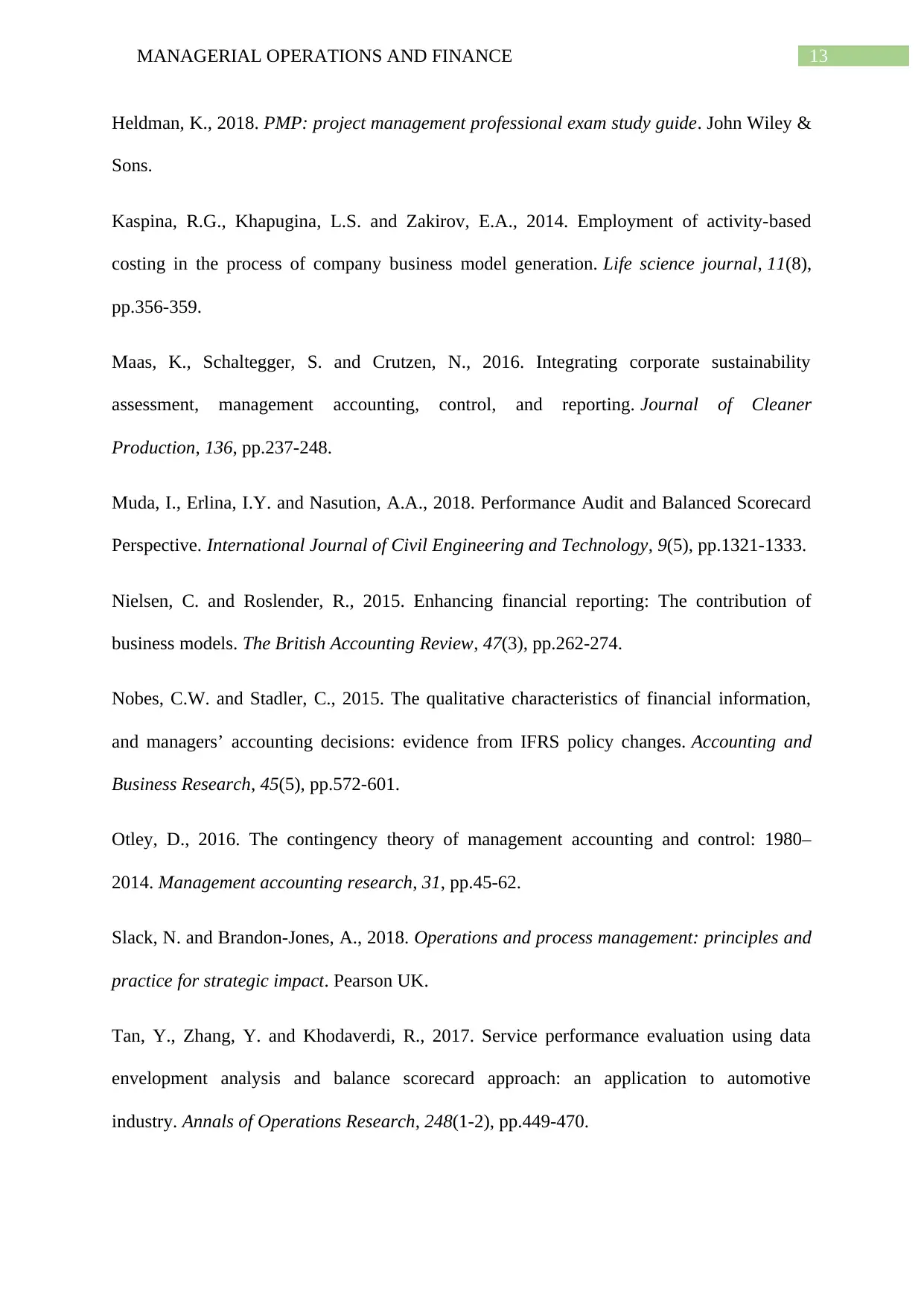
13MANAGERIAL OPERATIONS AND FINANCE
Heldman, K., 2018. PMP: project management professional exam study guide. John Wiley &
Sons.
Kaspina, R.G., Khapugina, L.S. and Zakirov, E.A., 2014. Employment of activity-based
costing in the process of company business model generation. Life science journal, 11(8),
pp.356-359.
Maas, K., Schaltegger, S. and Crutzen, N., 2016. Integrating corporate sustainability
assessment, management accounting, control, and reporting. Journal of Cleaner
Production, 136, pp.237-248.
Muda, I., Erlina, I.Y. and Nasution, A.A., 2018. Performance Audit and Balanced Scorecard
Perspective. International Journal of Civil Engineering and Technology, 9(5), pp.1321-1333.
Nielsen, C. and Roslender, R., 2015. Enhancing financial reporting: The contribution of
business models. The British Accounting Review, 47(3), pp.262-274.
Nobes, C.W. and Stadler, C., 2015. The qualitative characteristics of financial information,
and managers’ accounting decisions: evidence from IFRS policy changes. Accounting and
Business Research, 45(5), pp.572-601.
Otley, D., 2016. The contingency theory of management accounting and control: 1980–
2014. Management accounting research, 31, pp.45-62.
Slack, N. and Brandon-Jones, A., 2018. Operations and process management: principles and
practice for strategic impact. Pearson UK.
Tan, Y., Zhang, Y. and Khodaverdi, R., 2017. Service performance evaluation using data
envelopment analysis and balance scorecard approach: an application to automotive
industry. Annals of Operations Research, 248(1-2), pp.449-470.
Heldman, K., 2018. PMP: project management professional exam study guide. John Wiley &
Sons.
Kaspina, R.G., Khapugina, L.S. and Zakirov, E.A., 2014. Employment of activity-based
costing in the process of company business model generation. Life science journal, 11(8),
pp.356-359.
Maas, K., Schaltegger, S. and Crutzen, N., 2016. Integrating corporate sustainability
assessment, management accounting, control, and reporting. Journal of Cleaner
Production, 136, pp.237-248.
Muda, I., Erlina, I.Y. and Nasution, A.A., 2018. Performance Audit and Balanced Scorecard
Perspective. International Journal of Civil Engineering and Technology, 9(5), pp.1321-1333.
Nielsen, C. and Roslender, R., 2015. Enhancing financial reporting: The contribution of
business models. The British Accounting Review, 47(3), pp.262-274.
Nobes, C.W. and Stadler, C., 2015. The qualitative characteristics of financial information,
and managers’ accounting decisions: evidence from IFRS policy changes. Accounting and
Business Research, 45(5), pp.572-601.
Otley, D., 2016. The contingency theory of management accounting and control: 1980–
2014. Management accounting research, 31, pp.45-62.
Slack, N. and Brandon-Jones, A., 2018. Operations and process management: principles and
practice for strategic impact. Pearson UK.
Tan, Y., Zhang, Y. and Khodaverdi, R., 2017. Service performance evaluation using data
envelopment analysis and balance scorecard approach: an application to automotive
industry. Annals of Operations Research, 248(1-2), pp.449-470.
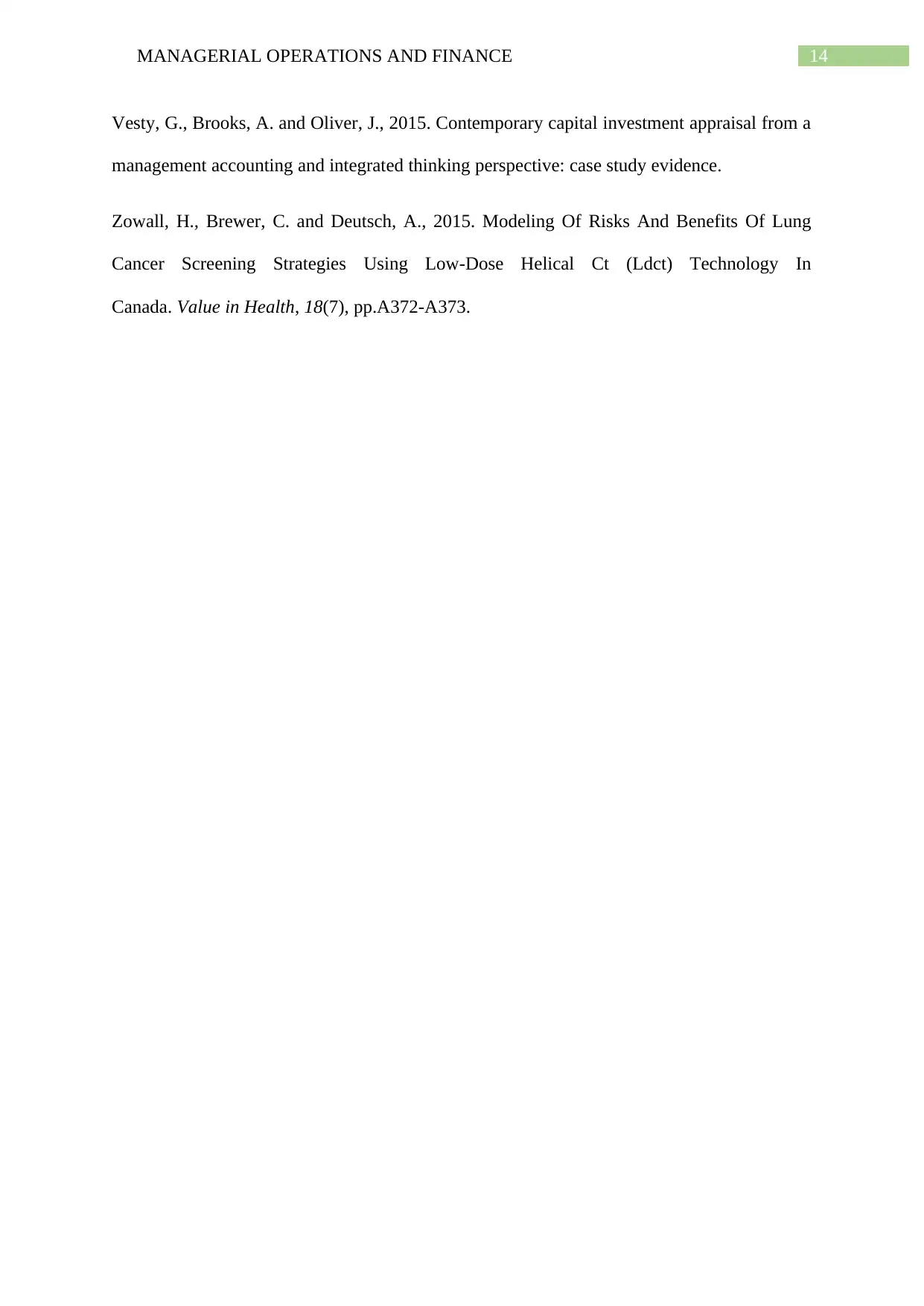
14MANAGERIAL OPERATIONS AND FINANCE
Vesty, G., Brooks, A. and Oliver, J., 2015. Contemporary capital investment appraisal from a
management accounting and integrated thinking perspective: case study evidence.
Zowall, H., Brewer, C. and Deutsch, A., 2015. Modeling Of Risks And Benefits Of Lung
Cancer Screening Strategies Using Low-Dose Helical Ct (Ldct) Technology In
Canada. Value in Health, 18(7), pp.A372-A373.
Vesty, G., Brooks, A. and Oliver, J., 2015. Contemporary capital investment appraisal from a
management accounting and integrated thinking perspective: case study evidence.
Zowall, H., Brewer, C. and Deutsch, A., 2015. Modeling Of Risks And Benefits Of Lung
Cancer Screening Strategies Using Low-Dose Helical Ct (Ldct) Technology In
Canada. Value in Health, 18(7), pp.A372-A373.
You're viewing a preview
Unlock full access by subscribing today!
1 out of 15
Related Documents
Your All-in-One AI-Powered Toolkit for Academic Success.
+13062052269
info@desklib.com
Available 24*7 on WhatsApp / Email
![[object Object]](/_next/static/media/star-bottom.7253800d.svg)
Unlock your academic potential
© 2024 | Zucol Services PVT LTD | All rights reserved.





